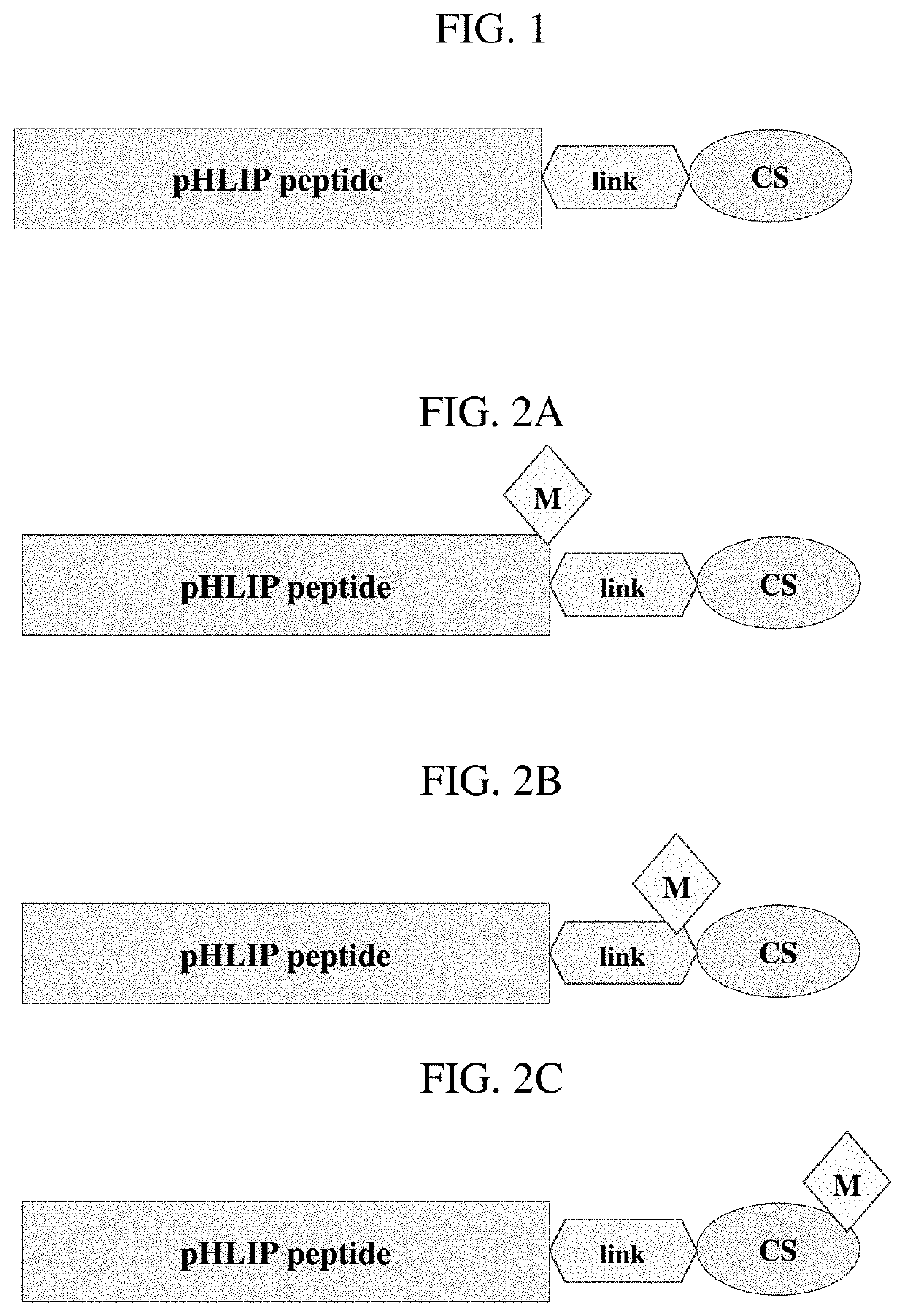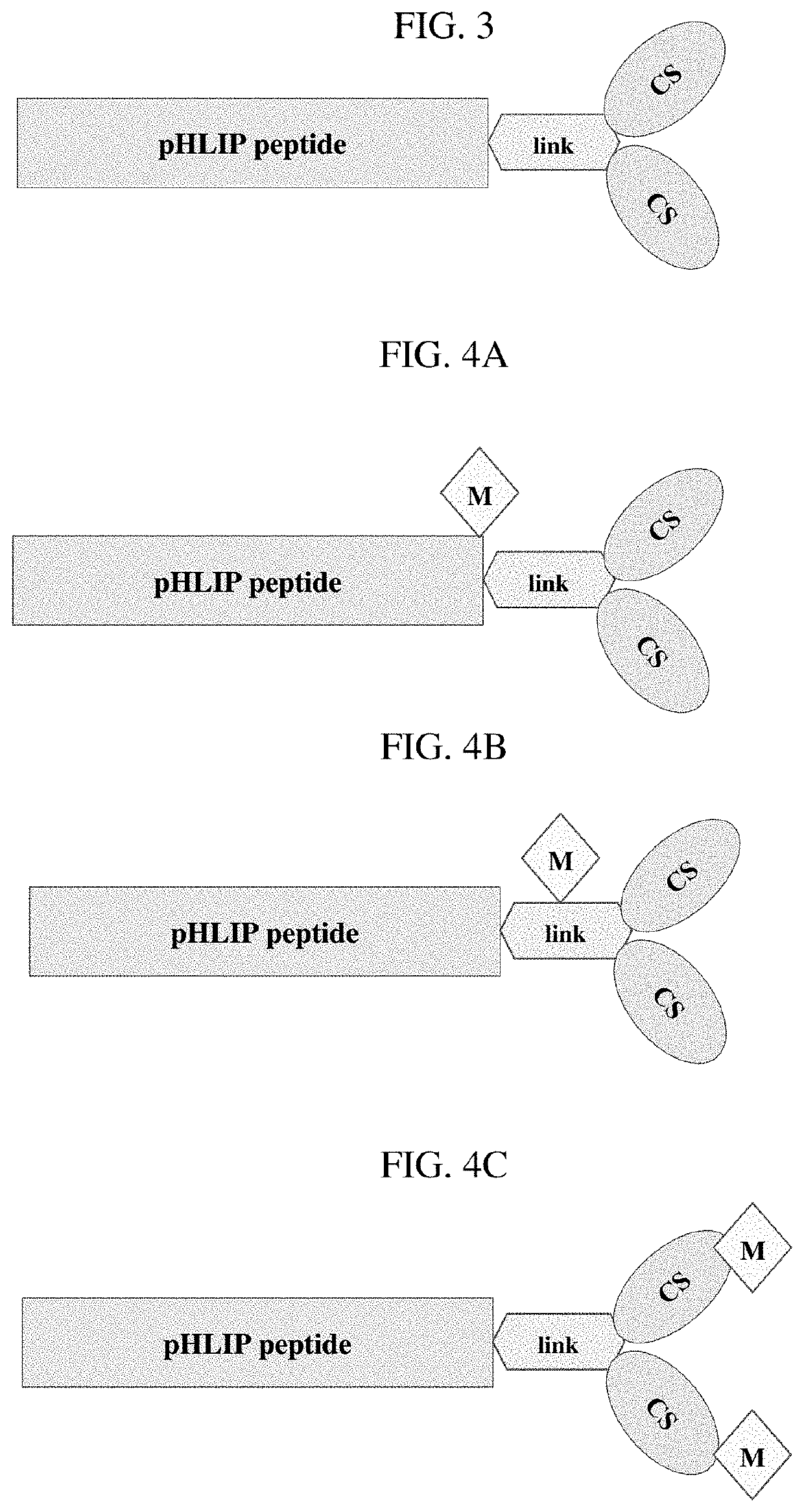Phlip®-mediated targeting of corticosteroids to diseased tissue
a corticosteroids and phlip® technology, applied in the field of corticosteroids targeted therapy, can solve the problems of slow development, serious side effects of systemic and non-targeted use of corticosteroids, and restrict the duration of administration, so as to improve the effective use of corticosteroids, avoid systemic immunosuppression and other off-target effects, and reduce the exposure of healthy tissue
- Summary
- Abstract
- Description
- Claims
- Application Information
AI Technical Summary
Benefits of technology
Problems solved by technology
Method used
Image
Examples
example 1
n of ICG-pHLIP Targeting of Inflamed Lungs in a Mouse LPS-Induced Model of Pulmonary Inflammation
[0135]The main goal of this study demonstrated the ability of pHLIP® to target inflamed tissue. Inflammation in lungs is induced by LPS (Lipopolysaccharides from E. coli 0111: B4) challenge, which is well-established model of inflammation. CD-1 male mouse, 6 to 7 weeks and 32-38 grams from Charles River Labs are used in the study. Mice were anesthetized by ketamine hydrochloride / xylazine hydrochloride by intraperitoneal injection and allowed 5 minutes to reach maximal anesthesia. For intranasal administration of LPS mice were suspended by the upper jaw, such that the nose and trachea were lined up vertically directly above the bronchi, to allow optimal inhalation and passive gravitational flow of LPS directly to the lungs. 50 μg (in 50 μl) LPS were instilled into the nares in five boluses of 10 μl each. Mice were maintained in their vertical orientation for 5 minutes following the last b...
example 2
n of pHLIP-Dexa Treatment of Inflamed Lungs in a Mouse LPS-Induced Model of Pulmonary Inflammation
[0137]Since inflamed lungs were targeted by pHLIP®, pHLIP-Dexa was evaluated, where Dexa is a dexamethasone, to suppress inflammation in lungs. Dexamethasone-propionyl-PEG(4)-SPDP (Dexa-PEG4-SPDP) (FIG. 18A) was synthesized and purified by Iris Biotech. pHLIP-Dexa (FIG. 18B) was prepared by conjugation of pHLIP® (Var3) with single Cys residue at the C-terminal inserting end with Dexa-PEG4-SPDP. The Var3 pHLIP® peptide used in the study: ADDQNPWRAYLDLLFPTDTLLLDLLWCA (SEQ ID NO: 3) was prepared by solid-phase synthesis. The peptide and Dexa-PEG4-SPDP were dissolved in DMSO and mixed to have molar ratio 1:1. 100 mM sodium phosphate, 150 mM NaCl buffer, pH 7.2 (saturated with argon is added to reaction mix ( 1 / 10 of total volume). Reaction mixture was incubated at room temperature for 2 hours and the reaction progress was monitored by the analytical reverse phase HPLC (Zorbax SB-C18 column ...
example 3
n of pHLIP-Dexa Treatment of Inflamed and Injured Lungs in a Mouse Bleomycin-Induced Lung Injury Model
[0140]Intranasal administration of bleomycin induces a significant pulmonary inflammation in mice, which typically progresses to fibrosis and eventually leads to mice death. pHLIP-Dexa was evaluated for the ability to reduce bleomycin-induced inflammation in lungs.
[0141]CD-1 male mouse, 6 to 7 weeks and 32-38 grams from Charles River Labs were used in the study. Bleomycin sulfate (4 Units / kg) in 50 μL (a solution of 2 Units / ml for 25 g mouse) was prepared in 0.9% NaCl. Bleomycin or saline was intranasally dosed on Day 0. pHLIP-Dexa in PBS / 5% DMSO (4.6 mg / kg), Dexa (dexamethasone alone at dose of 0.46 mg / kg, which corresponds to the same number of molecules of Dexa in pHLIP-Dexa) or vehicle (PBS / 5% DMSO) were dosed daily from day 0 to day 7. On Day 0, 3, 5 and 8 blood glucose was measured and body weights are recorded. On Day 8, all mice were euthanized. Lung tissues were collected a...
PUM
| Property | Measurement | Unit |
|---|---|---|
| mass | aaaaa | aaaaa |
| mass | aaaaa | aaaaa |
| mass | aaaaa | aaaaa |
Abstract
Description
Claims
Application Information
 Login to View More
Login to View More - R&D
- Intellectual Property
- Life Sciences
- Materials
- Tech Scout
- Unparalleled Data Quality
- Higher Quality Content
- 60% Fewer Hallucinations
Browse by: Latest US Patents, China's latest patents, Technical Efficacy Thesaurus, Application Domain, Technology Topic, Popular Technical Reports.
© 2025 PatSnap. All rights reserved.Legal|Privacy policy|Modern Slavery Act Transparency Statement|Sitemap|About US| Contact US: help@patsnap.com



